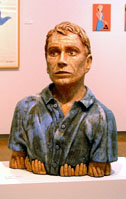|

Comment
on this story
What:
Knoxville and Vicinity: MFA Alumni
Where:
Ewing Gallery inside the Art & Architecture Building on the UT campus
When:
Gallery open daily thru Aug. 10, with artists' reception 2-4 p.m. Aug. 10. Call 974-3200 for information
|
|

Exhibit merely hints at grads' accomplishments
by Jonathan Kelly
While attending a university, artists study the craft while surrounded by peers and professors. They're shielded from the harsher realities of the art world by a system built to encourage self-expression. But on graduation they encounter the less savory people involved with art. There's the prospective buyer, someone who spends money based on a painting's color scheme, not its meaning. There's the average viewer, someone who doesn't know the history of the form and doesn't care about the larger context. Then there's the fill-in art columnist, a writer and musician who is ignorant of the skills in creating visual art, yet strongly opinionated on what art should accomplish. That would be me. Hi.
"Knoxville and Vicinity: MFA Alumni," the exhibit currently at the Ewing Gallery in the Art and Architecture building, is billed as a checkup on artists who earned their MFA degrees at UT and still live in the area. The exhibit should be an indicator of how the artists are faring in the real world, where to survive you must sell. And it is an indicator. Sort of.
While some of the artists graduated as far back as 1986, nearly half of the 30-plus artists whose work is being shown graduated in 2003, which means their pieces were almost certainly student work. This isn't a slight against the artists or their work; it's just that the show is split: half is a checkup on locals; the other is a victory lap for recent graduates.
This division aside, there's still a disjointed feel to the entire exhibit. When there are 37 artists, most of whom have only two submissions, and no information is provided except the artist's name, graduation date, the name and date of the piece, and the format, it's difficult to tell what anyone is trying to say or accomplish. For example, Josh Hartwigsen's "Tied," a pencil drawing of a bird tied to a branch with wire, was skillfully and meticulously drawn. So was its companion, "Backwards," its subject a bird in flight. The question is, what's the purpose? I could make up some sort of interpretation for the bird tied to the branch, but it wouldn't be terribly deep. Plus, when the pieces are obviously part of a series, I feel like I'm missing a huge chunk of what Hartwigsen is getting at. But that's all I have. Of course, maybe there is no larger intent. Maybe he just likes drawing birds. There's no way to tell.
Much of the work is like this. I could grasp an artist's preferred format, and maybe a preferred subject, but emotionally the whole experience is somewhat empty. Again, it's hard to say if this is a problem with the artists or a limitation of the exhibit. It's hard to work up any emotion when you're going to look at something completely different two steps over.
There are exceptions, of course. Kelly Barrett's ceramics earn points for disturbing imagery. "The Id, the Bunny, and the Worm" and "The Id is Hungry" (again, part of a series), personify the human subconscious as a sort of sprite with horns. They're reminiscent of those mail order Jesus-playing-sports ceramics, only instead of Jesus helping Billy play baseball, it's the Id clutching a stuffed rabbit and riding a very large ridged worm that juts out of its crotch like a misshapen phallus. In the next piece, the Id is feasting on what looks like the same worm, licking meat from its ripped-open belly with a gigantic tongue. The symbolism is strong and clear, if the results are a bit stomach-churning.
Still, some artists excel, even with only two pieces. Lee Marchalonis shows depth and range with her selections. "La Lanceuse dePole" is a lithograph of a girl with flaming red hair brandishing a frying pan. The lines are simple and bold, and the colors vibrant. In less delicate hands the image would scream with feminism, but here it's more a smirk than a scream. This piece is in sharp contrast with her "The Seedeater's Paradise," a dark and extremely detailed lithograph of two pigeons standing in front of the silhouette of a city skyline. Even if I don't know the exact meaning of this contrast of nature and industry, there is obviously intent behind the work.
Michelle Dussalt's "Keep Your Eyes on the Prize" is also quite good. A young woman's face in profile stares at what, to me, resembles a giant glass of red wine. The wine is dark and turbulent, and an older woman, a sort of apparition with flower-patterned hair and skeletal legs (you just have to see it, it's creepy) points the way. It's overtly sexual, but not overly serious. The border of the wine glass, which at first seems to be gold squiggles, is actually a row of tiny 69's. It's juvenile, but I laughed.
While I've barely touched on the art being shown, I will say that it's an exhibit worth viewing, if only to get a sense of what the university's MFA program can produce. However, I'd recommend going on Aug. 10, the last day, which is also the artists' reception. Go, find something you like, and pick the artist's brain. It should be enlightening.

July 31, 2003 * Vol. 13, No. 31
© 2003 Metro Pulse
|